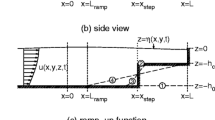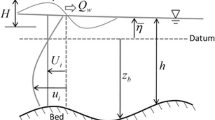Abstract
Two-dimensional (2D) and three-dimensional (3D) hydrodynamic models are used to simulate the hurricane-induced storm surge and coastal inundation in regions with vegetation. Typically, 2D storm surge models use an enhanced Manning coefficient while 3D storm surge models use a roughness height to represent the effects of coastal vegetation on flow. This paper presents a 3D storm surge model which accurately resolves the effects of vegetation on the flow and turbulence. First, a vegetation-resolving 1DV Turbulent Kinetic Energy model (TKEM) is introduced and validated with laboratory data. This model is both robust enough to accurately model flows in complex canopies, while compact and efficient enough for incorporation into a 3D storm surge-wave modeling system: Curvilinear Hydrodynamics in 3D-Surface WAves Nearshore (CH3D-SWAN). Using the 3D vegetation-resolving model, three numerical experiments are conducted. In the first experiment, comparisons are made between the 2D Manning coefficient approach and the 3D vegetation-resolving approach for simple wind-driven flow. In a second experiment, 2D and 3D representations of vegetation produce similar inundations from the same hurricane forcing, but differences in momentum are found. In a final experiment, varying inundation between seemingly analogous 2D and 3D representations of vegetation are demonstrated, pointing to a significant scientific need for data within wetlands during storm surge events. This study shows that the complex flow structures within vegetation canopies can be accurately simulated using a vegetation-resolving 3D storm surge model, which can be used to assess the feasibility for future wetland restoration projects.












Similar content being viewed by others
References
Blumberg, A.F. 1977. Numerical tidal model of Chesapeake Bay. Journal of the Hydralics Division 1: 12661–12671.
Bode, L., and T.A. Hardy. 1997. Progress and recent developments in storm surge modeling. Journal of Hydraulic Engineering 123: 4. doi:10.1061/(ASCE)0733-9429(1997)123:4(315).
Chow, V.T. 1959. Open channel hydraulics. New York: McGraw Hill.
Holland, G.J. 1980. An analytic model of the wind and pressure profiles in hurricanes. Monthly Weather Review 108: 1212–1218.
Howes, N.C., D.M. FitzGerald, Z.J. Hughes, I.Y. Georgiou, M.A. Kulp, M.D. Miner, J.M. Smith, and J.A. Barras. 2010. Hurricane induced failure of low salinity wetlands. Proceedings of the National Academy of Sciences 107: 14014–14019. doi:10.1073/pnas.0914582107.
IPET. 2008. The New Orleans hurricane protection system. Washington, D.C.: The National Academies Press.
Krauss, Ken. W., Doyle, Thomas W., Doyle, Terry J., Swarzenski, Christopher M., From, Andrew S., Day, Richard H., and Connor, William H. (2009). Water level observations in mangrove swamps during two hurricanes in Florida. Wetlands 29: 142–149. doi:10.1672/07-232.1
Lewellen, W.S., and Y. Peter Sheng. 1980. Modeling of dry deposition of SO2 and sulfate aerosols. Research Report, Princeton, NJ: Electric Power Research Institute.
Loder, Nicolas, Jennifer L. Irish, M.A. Cialone, and T.V. Wamsley. 2009. Sensitivity of hurricane surge to morphological parameters of coastal wetlands. Estuarine, Coastal and Shelf Science. doi:10.1016/j/ecss.2009.07.036.
Louisiana Coastal Wetlands Conservation and Restoration Task Force (2010). The 2009 Evaluation Report to the U.S. Congress on the Effectiveness of Coastal Wetlands Planning, Protection, and Restoration Projects Act. The United States Army Corps of Engineers.
Nepf, Heidi, and E.R. Vivoni. 2000. Flow structure in depth-limited, vegetated flow. Journal of Geophysical Research: Oceans 105 C12. doi:10.1029/2000JC900145.
Neumeier, Urs. 2005. Quantification of vertical density variations of salt-marsh vegetation. Estarine, Coastal and Shelf Science. doi:10.1016/j.ecss.2004.12.009.
Neumeier, Urs. 2007. Velocity and turbulence variations at the edge of saltmarshes. Continental Shelf Research 27: 1046–1059. doi:10.1016/j.csr.2005.07.009.
Novak, Micheal, Jon Warland, Alberto Orchansky, Rick Ketler, and Steven Green. 2000. Wind tunnel and field measurements of turbulent flow in forests. Part I: Uniformly thinned strands. Boundary Layer Meteorology. doi:10.1023/A:1002693625637.
NYS 2100 Commission. (2012). Recommendations to Improve the Strength and Resiliance of the Empire State’s Infrastructure. New York: The Rockefeller Foundation
Pope, Stephen B. 2010. Turbulent flows. New York: Cambridge University Press.
Rego, João, and Chunyan Li. 2010. Storm surge propagation in Galveston Bay during Hurricane Ike. Journal of Marine Systems. doi:10.1016/j.jmarsys.2010.06.001.
Seavitt, Catherine. 2013. Soft infrastructure—resilient ecologies for New York’s waterfront. St. Augustine, FL: Coastal Hazards Summit.
Sheng, Y.P., V. Alymov, and V. Paramygin. 2010. Simulation of storm surge, wave, currents, and inundation in the Outer Banks and Chesapeake Bay during Hurricane Isabel in 2003: the importance of waves. Journal of Geophysical Research:Oceans. doi:10.1029/2009JC005402.
Sheng, Y.P., A. Lapetina, and G. Ma. 2012. The reduction of storm surge by vegetation canopies: three-dimensional simulations. Geophysical Research Letters. doi:10.1029/2012GL053577.
Sheng, Y.P., and T. Liu. 2011. Three-dimensional simulation of wave-induced circulation: comparison of three radiation stress formulations. Journal of Geophysical Research:Oceans 116, C05021. doi:10.1029/2010JC006765.
Sheng, Y.P., and C. Villaret. 1989. Modeling the effect of suspended sediment stratification on bottom exchange processes. Journal of Geophysical Research: Oceans. 94, C01498. doi:10.1029/JC094iC10p14429.
Suzuki, T., M. Zijlema, B. Burger, M. Meijer, and S. Narayan. 2012. Wave dissipation by vegetation with layer schematization in SWAN. Coastal Engineering. doi:10.1016/j.coastaleng.2011.07.006.
Temmerman, S., T.J. Bouma, G. Govers, Z.B. Wang, M.B. De Vries, and P.M.J. Herman. 2005. Impact of vegetation on flow routing and sedimentation patterns: three-dimensional modeling for a tidal marsh. Journal of Geophysical Research: Earth Surface. doi:10.1029/2005JF000301.
Wamsley, T.V., M. Cialone, J.M. Smith, J.H. Atkinson, and J. Rosati. 2010. The potential of wetlands in reducing storm surge. Ocean Engineering. doi:10.1016/j.oceaneng.2009.07.018.
Weaver, R. and Luettich, R. (2009). 2D vs. 3D storm surge sensitivity in ADCIRC: case study of Hurricane Isabel. Proceedings of the 11th International Conference of Estuarine and Coastal Modeling. 762–779. Seattle, WA: American Society of Civil Engineers
Weisberg, Robert, and Lianyuan Zhang. 2008. Hurricane storm surge simulations comparing three-dimensional with two-dimensional formulations based on an Ivan-like storm over the Tampa Bay, Florida region. Journal of Geophysical Research: Oceans. 113, C12001. doi:10.1029/2008JC005115.
Wilson, N.R., and R. Shaw. 1977. A higher order closure model for canopy flow. Journal of Applied Meteorology 16: 1197–1205.
Zhang, K., H. Liu, Y. Li, H. Xu, J. Shen, J. Rhome, and T.J. Smith. 2012. The role of mangroves in attenuating storm surges. Estuarine, Coastal and Shelf Science 102–103: 11–23. doi:10.1016/j.ecss.2012.02.021.
Acknowledgments
This study is supported by the University of Florida, Florida Sea Grant Project R/C-S-55, the U.S. IOOS Program Project IOOS.11(033), and the National Oceanic and Atmospheric Administration National Climate Services Project #NA11OAR4310105).
Author information
Authors and Affiliations
Corresponding author
Additional information
Communicated by Robert D. Hetland
Appendix
Appendix
This is an extended derivation of the TKE model from the original RSM (Lewellen and Peter Sheng 1980). In the limit of no vegetation, the RSM from which this TKE model is derived is equivalent to the RSM for vegetation-free flow described in Sheng and Villaret (1989).
For simplicity, the RANS equations for the RSM are written in tensor form:
Mean Continuity Equation
Mean Momentum Eqn.
Reynolds Stress Equation
where (i, j, k) = (1, 2, 3), x i are coordinate axes, t is time, (u i , u j , u k ) are the mean velocity components, (u i ’ , u j ’, u k ’ ) are the fluctuating velocity components, the overbar represents the Reynolds averaging, g is gravitational acceleration, ε ijk is alternating tensor, Ω is the Earth’s rotation, δ ij is the Kronecker delta, q is the total rms fluctuating velocity, κ is molecular diffusivity, and λ is the turbulence macroscale which is a measure of the average turbulent eddy size. The right hand side of Eqn. 7, which represents the dynamic equation for the Reynolds stresses, contains two vegetation terms, two shear production terms, two rotation terms, one diffusion term, one tendency towards isotropy term, and one dissipation term (Sheng and Villaret 1989). While the general RSM and TKEM include the buoyancy effects associated with temperature and salinity variation in the flow, those terms are neglected here for simplicity. In the 1DV model for vegetation, only vertical gradients in the momentum equation are considered.
In the Reynolds stress equations, both a source and a sink term have been added:
where the first term represents the creation of wake turbulence due to the profile drag, and the second term recognizes the dissipation of Reynolds stress by the skin friction.
Eqn. A3 can be simplified as:
and the dynamics of turbulence are represented by the following equation for q 2:
Rights and permissions
About this article
Cite this article
Lapetina, A., Sheng, Y.P. Three-Dimensional Modeling of Storm Surge and Inundation Including the Effects of Coastal Vegetation. Estuaries and Coasts 37, 1028–1040 (2014). https://doi.org/10.1007/s12237-013-9730-0
Received:
Revised:
Accepted:
Published:
Issue Date:
DOI: https://doi.org/10.1007/s12237-013-9730-0




